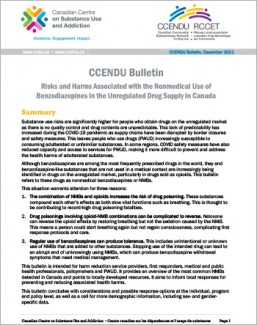Risks and Harms Associated with the Nonmedical Use of Benzodiazepines in the Unregulated Drug Supply in Canada

Summary
Substance use risks are significantly higher for people who obtain drugs on the unregulated market as there is no quality control and drug contents are unpredictable. This lack of predictability has increased during the COVID-19 pandemic as supply chains have been disrupted by border closures and safety measures. This leaves people who use drugs (PWUD) increasingly susceptible to consuming adulterated or unfamiliar substances. In some regions, COVID safety measures have also reduced capacity and access to services for PWUD, making it more difficult to prevent and address the health harms of adulterated substances.
Although benzodiazepines are among the most frequently prescribed drugs in the world, they and benzodiazepine-like substances that are not used in a medical context are increasingly being identified in drugs on the unregulated market, particularly in drugs sold as opioids. This bulletin refers to these drugs as non medical benzodiazepines or NMBs.
This situation warrants attention for three reasons:
1. The combination of NMBs and opioids increases the risk of drug poisoning. These substances compound each other’s effects as both slow vital functions such as breathing. This is thought to be contributing to record-high drug poisoning fatalities.
2. Drug poisonings involving opioid-NMB combinations can be complicated to reverse. Naloxone can reverse the opioid effects by restoring breathing but not the sedation caused by the NMB. This means a person could start breathing again but not regain consciousness, complicating first response protocols and care.
3. Regular use of benzodiazepines can produce tolerance. This includes unintentional or unknown use of NMBs that are added to other substances. Stopping use of the intended drug can lead to an abrupt end of unknowingly using NMBs, which can produce benzodiazepine withdrawal symptoms that need medical management.
This bulletin is intended for harm reduction service providers, first responders, medical and public health professionals, policymakers and PWUD. It provides an overview of the most common NMBs detected in Canada and points to locally developed resources. It aims to inform local responses for preventing and reducing associated health harms.
This bulletin concludes with considerations and possible response options at the individual, program and policy level, as well as a call for more demographic information, including sex- and gender specific data.